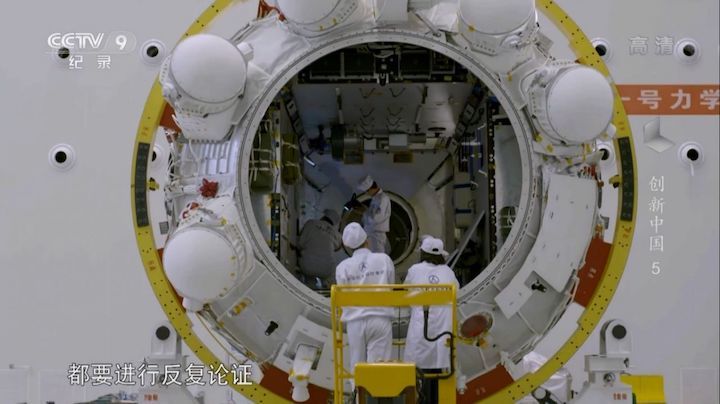The launch of the first module for the planned Chinese Space Station has slipped to 2020, officials from the space programme have said at the country's parliamentary sessions.
Zhou Jianping, chief designer of China's human spaceflight programme and a member of the national political consultative conference, or CPPCC, which forms part of the country's ongoing annual parliamentary sessions, told China News Service on Monday that the core module, 'Tianhe', will launch 'around 2020'.
The Tianhe module will be the core of the three-module Chinese Space Station (CSS), and will be joined by two experiment modules, named Wentian and Mengtian, by around 2022.
Once completed, China aims to keep the CSS permanently crewed with teams of three astronauts, each staying for 3-6 months a time, for at least a decade, carrying out science experiments and potentially hosting experiments, crews and even further modules from other countries through an agreement with the United Nations.
Launch of Tianhe had earlier been planned for 2018, but the launch failure in July last year of the Long March 5 rocket, a heavy-lift launch vehicle required to loft the 20-tonne space station modules to low Earth orbit, meant a delayed schedule.
The next attempt at a Long March 5 launch, which will send a large telecommunications satellite into a geostationary transfer orbit, will take place from Wenchang in the second half of 2018.
If that is successful, it will pave the way for a test launch of the low Earth orbit variant of the rocket, the Long March 5B, around June 2019. The follow-up flight will then launch the Tianhe module, now set to take place in 2020.

The first Long March 5 rocket being rolled out for launch at Wenchang in late October 2016.
The delay is not without consequences. China began on the road to the CSS in 1992 with the approval of the 921 Project, to develop human spaceflight capabilities, small space labs and the larger space station.
“China's willingness to think long term has served it well, but the project has been running for 25 years. For China to move forward – toward the Moonmost likely – it will need to wrap up the development stage of 921,” Joan Johnson-Freese, professor at the Naval War College, told gbtimes.com at the time of the Long March 5 debut, expressing her personal views.
China is working on a range of expanded robotic lunar plans as well as asuper-heavy-lift launch vehicle which would be able to facilitate human landings on the Moon in the 2030s.

A rendering of the completed Chinese Space Station, including docked Shenzhou and Tianzhou spacecraft.
Tianhe module, CSS construction
The Tianhe module, with the name meaning 'harmony of the heavens', has already been completed, having been developed by the China Academy of Space Technology (CAST), at the Assembly, Integration and Testing (AIT) Centre in Tianjin, North China.
The module features life support systems developed and improved through the stepping stone Tiangong space lab missions, including the ability to recycle a high rate of water from respiration and excretion.
After its launch Tianhe will be visited by a Tianzhou cargo craft followed by a crewed Shenzhou mission. The two experiment modules will follow these, along with an 'optical module', a two-metre diameter space telescope similar to the Hubble Space Telescope but with a wider field of view.
Bao Weimin of the China Aerospace Science and Technology Corporation (CASC), the country's main space contractor and to which CAST is a subordinate, told press last year that the CSS project will require more than a dozen launches, including launching modules, Tianzhou cargo vessels and Shenzhou crewed missions to the facility.

The Tianhe core module for the Chinese Space Station (CSS) being tested along with the docking hub at the Tianjin Assembly, Integration and Testing (AIT) Centre.
Space station preparations
China's astronauts are already preparing for CSS missions, with extra vehicular activity (EVA) or 'space walk' training, as well as emergency sea landing training, which took place along with two European Space Agency astronauts last August.
Yang Liwei, China's first astronaut in space in 2003, and who is also a CPPCC member and the deputy director of China's crewed space program office, said on Saturday that the country plans to soon select a third round of astronauts, including flight engineers, and payload specialists, including women.
Whereas the first two groups, selected in 1998 and 2010 drew from air force pilots to take part in the first Shenzhou crewed missions and stays aboard experimental Tiangong space labs, the new group will include individuals selected from research institutions.

The 11 Chinese astronauts involved in the country's six human spaceflight missions mark the 20th anniversary of the founding of the astronaut corps at Space City in Beijing in January 2018.
Zhang Bainan, a top official within the human spaceflight programme, said they are working to improve the Shenzhou crewed spacecraft.
"We have finished testing Shenzhou's coordination with space modules and decided the details of Shenzhou crewed spacecraft and Tianzhou cargo spacecraft that will be used for future space station construction. Breakthroughs have been made in relevant technologies such as manned space transportation, space docking, Tianzhou's supply capability and propellant refueling," Zhang told state media.

The crewed Shenzhou-10 spacecraft docking with Tiangong-1 space lab in June 2013.

